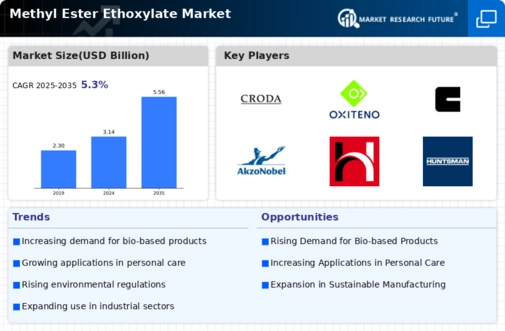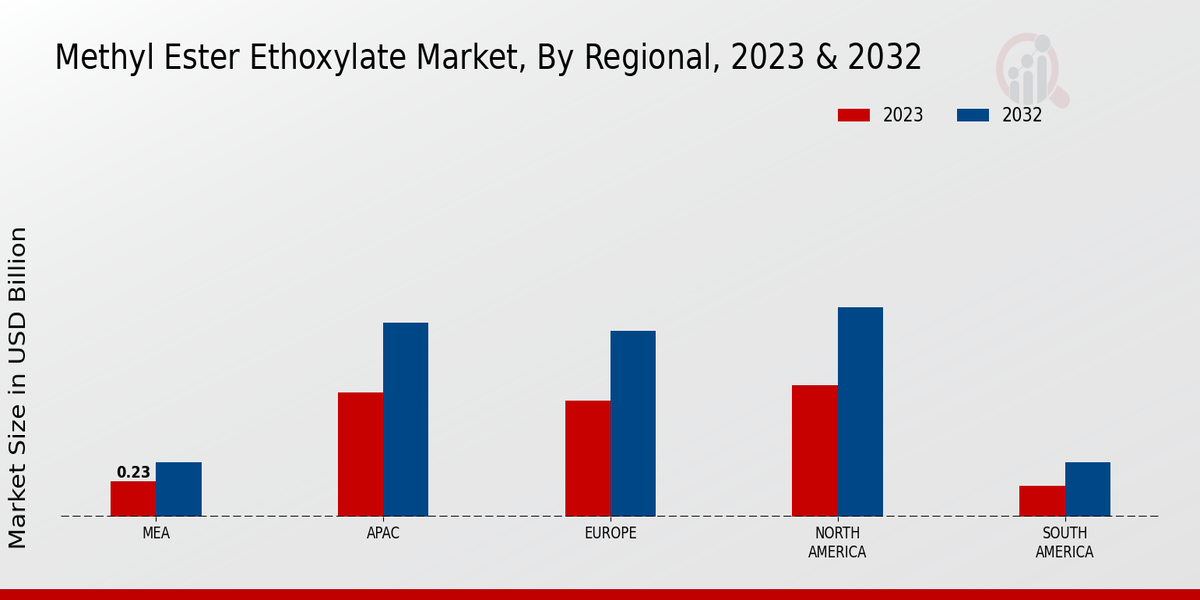Market Growth Projections
The Global Methyl Ester Ethoxylate Market Industry is projected to experience significant growth over the coming years. With a market size anticipated to reach 3.14 USD Billion in 2024 and further expand to 5.56 USD Billion by 2035, the industry is on a promising trajectory. The compound annual growth rate (CAGR) of 5.33% from 2025 to 2035 reflects the increasing adoption of methyl ester ethoxylates across various applications, driven by factors such as sustainability, regulatory support, and technological advancements. These projections indicate a robust future for the industry, highlighting its potential in meeting the evolving demands of consumers and manufacturers.
Rising Demand for Eco-Friendly Surfactants
The Global Methyl Ester Ethoxylate Market Industry is experiencing a notable increase in demand for eco-friendly surfactants. As consumers and manufacturers alike become more environmentally conscious, there is a shift towards sustainable products. Methyl ester ethoxylates, derived from renewable resources, align with this trend. This shift is evident in various sectors, including personal care and household cleaning products, where companies are reformulating to include these biodegradable surfactants. The market is projected to reach 3.14 USD Billion in 2024, indicating a robust growth trajectory fueled by this demand for greener alternatives.
Regulatory Support for Biodegradable Products
The Global Methyl Ester Ethoxylate Market Industry benefits from increasing regulatory support for biodegradable products. Governments worldwide are implementing stricter regulations on synthetic surfactants due to environmental concerns. This regulatory landscape encourages manufacturers to adopt methyl ester ethoxylates, which are recognized for their lower environmental impact. The alignment of these regulations with consumer preferences for sustainable products is likely to drive market growth. As a result, the industry is poised for expansion, with a projected compound annual growth rate (CAGR) of 5.33% from 2025 to 2035, indicating a favorable environment for biodegradable surfactants.
Growth in Personal Care and Household Products
The Global Methyl Ester Ethoxylate Market Industry is significantly influenced by the growth of the personal care and household products sector. With increasing disposable incomes and changing consumer preferences, there is a rising demand for high-quality cleaning agents and personal care formulations. Methyl ester ethoxylates serve as effective emulsifiers and surfactants in these applications, enhancing product performance. This trend is expected to contribute to the market's expansion, with projections indicating a market size of 5.56 USD Billion by 2035. The continuous innovation in product formulations further supports this growth.
Technological Advancements in Production Processes
The Global Methyl Ester Ethoxylate Market Industry is witnessing technological advancements in production processes, which enhance efficiency and reduce costs. Innovations in manufacturing techniques, such as improved catalytic processes and the use of renewable feedstocks, are making the production of methyl ester ethoxylates more sustainable and economically viable. These advancements not only lower production costs but also improve product quality, making them more attractive to manufacturers. As the industry continues to evolve, these technological improvements are expected to play a crucial role in meeting the growing demand for methyl ester ethoxylates across various applications.
Increasing Awareness of Environmental Sustainability
The Global Methyl Ester Ethoxylate Market Industry is significantly impacted by the increasing awareness of environmental sustainability among consumers and businesses. As sustainability becomes a priority, companies are seeking to incorporate environmentally friendly ingredients into their products. Methyl ester ethoxylates, being derived from renewable resources, are gaining traction as a preferred choice for formulations in various industries, including agriculture and textiles. This heightened awareness is driving demand, as consumers are more likely to support brands that prioritize sustainability. Consequently, the market is expected to witness substantial growth, aligning with the broader trend towards sustainable practices.












